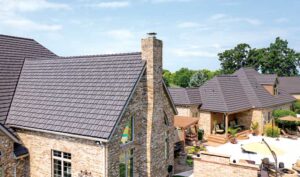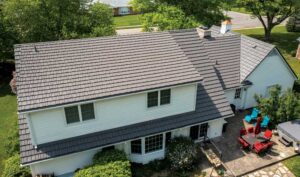
Residential metal roofing’s market share has ballooned over the last 40 years; as of 2022, the Metal Roofing Alliance (MRA) reported it at 18 percent, up six percent in the past three years.1 But new roofing materials, finishes, colors, and styles crop up every year, so why are homeowners increasingly choosing metal roofing?
Two reasons: cost-effectiveness and performance. Metal roofing offers a durable, high-quality solution at a premium. Despite these advantages, customer perception and comparatively higher costs have limited adoption.

Many consumers associate metal roofing with commercial or agricultural uses, unaware of technological advances in coatings, manufacturing, and design. Homeowners typically choose traditional asphalt shingles as they can be quickly installed and are cost efficient. However, a roof’s total cost is more than the installation and labor; it contains the entire life cycle of the roof—from maintenance to replacement.
Durable coatings like polyvinylidene fluoride (PVDF) and silicone-modified polyester (SMP) enable metal roofing to endure harsh weather and decades of wear. Fewer penetrations in the case of concealed-fastener metal roofs mean fewer points of failure for rain, wind, or debris. Metal roofing’s light weight allows for installation over existing roofing with an underlayment layer between. In addition, many metal roofing products boast fire-resistance ratings far superior to composite shingles. For example, images of a lone, red-roofed house amidst the destruction of the recent wildfires in Lahaina in western Maui, H.I. surfaced in many news reports. NPR (National Public Radio) reported the homeowner had taken several precautions against fire, including installing a metal roof to protect from flying embers.2

According to State Farm Insurance, metal roofs last anywhere from 40 to 70 years, while asphalt roofing materials have an estimated life expectancy of about 12 to 20.3 This gap in lifespan positions metal roofing as a long-term solution for homeowners who intend to stay put. In this case, choosing metal avoids a roof replacement entirely, as two (or three) asphalt roofs might be necessary to cover the same time frame as a single metal roof.
Beyond maintenance and replacement, roofs can pay for themselves with solar panels and power generation. Solar power on the rooftop is nothing new, but metal roofing’s longevity pairs nicely with the lifespan of the average solar panel. Asphalt roofs are more likely to need a replacement; this means a call to the solar installer to remove the panels and then the roofer to replace the roof. With metal, the solar panels are likely to need replacement before the roof, and removing panels is often non-invasive, with only clamped-on brackets to unscrew.
While metal roofing occupies a smaller portion of the residential roofing market, it will likely expand as awareness spreads. For many homeowners, metal roofing’s value proposition is exactly what they have been searching for. In certain climates, metal’s preventative power against the elements—or worse, catastrophic weather events—is hard to ignore, too. Regardless, metal roofing offers a compelling package for homeowners willing to invest.
Ethan Young is a content writer and photographer/videographer for Isaiah Industries. He writes for homeowners and professionals alike on all things metal roofing. For more information, visit isaiahindustries.com.
Notes
1 See www.metalroofing.com/news/record-breaking-growth-in-us-residential-metal-roofing-correlates-with-climate-extreme-impacts-desire-for-sustainability.
2 See www.npr.org/2023/08/24/1195331310/red-roof-house-fires-lahaina-hawaii.
3 See www.statefarm.com/simple-insights/residence/metal-roof-pros-and-cons.


